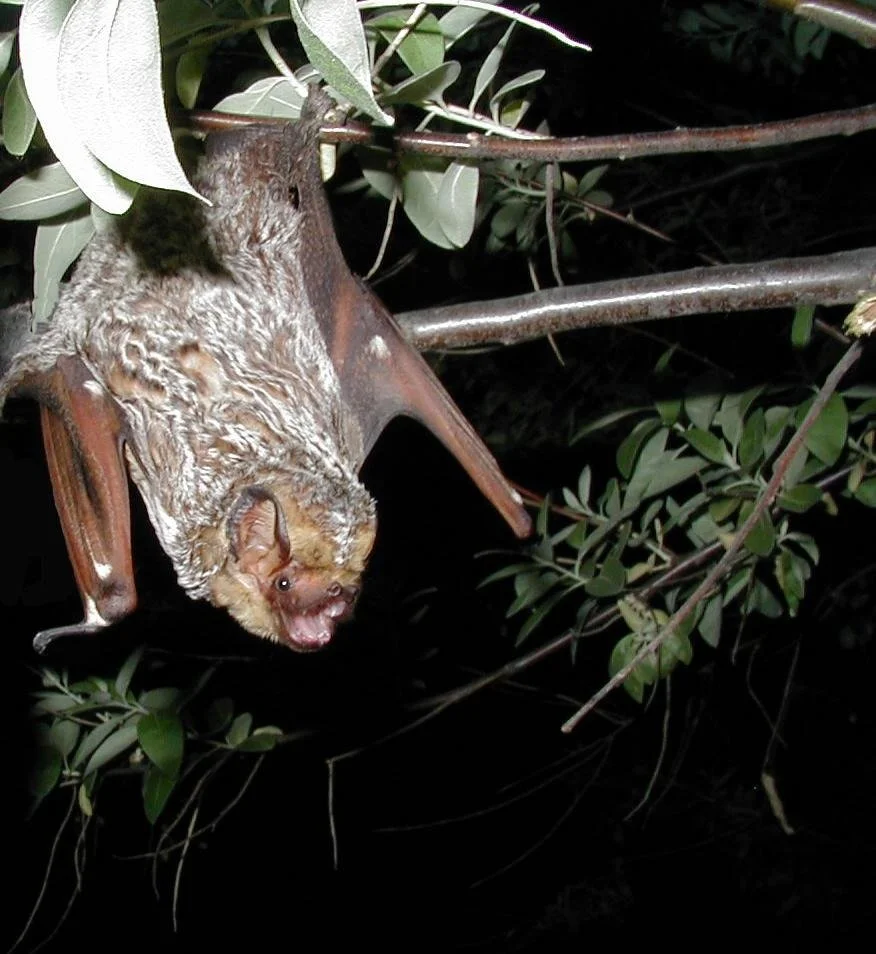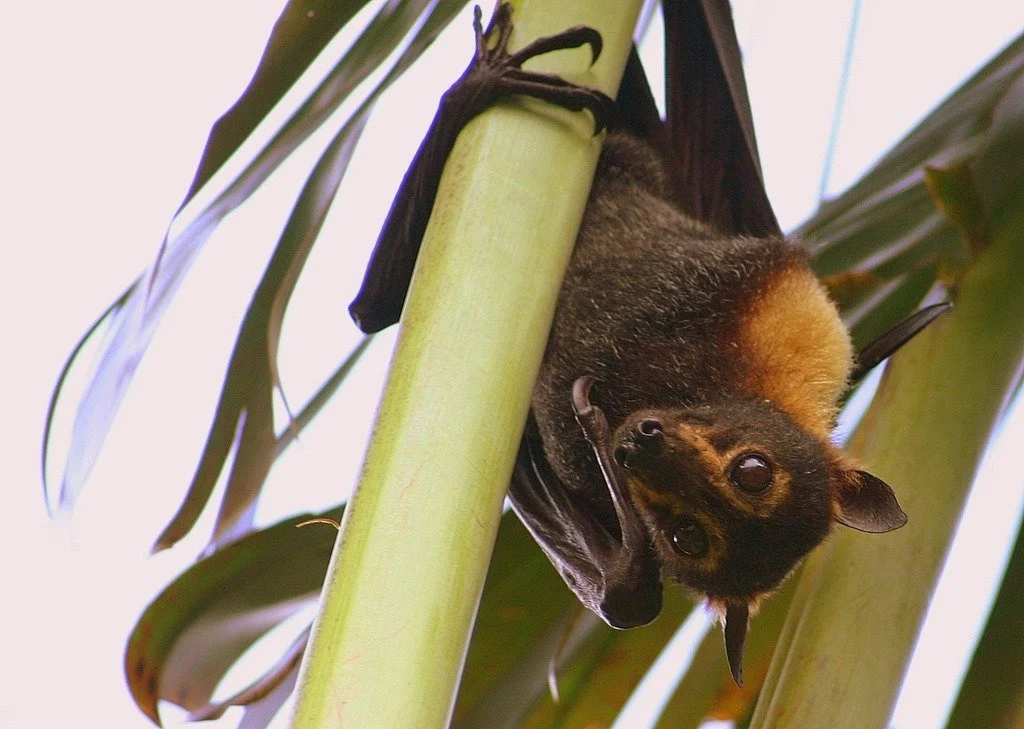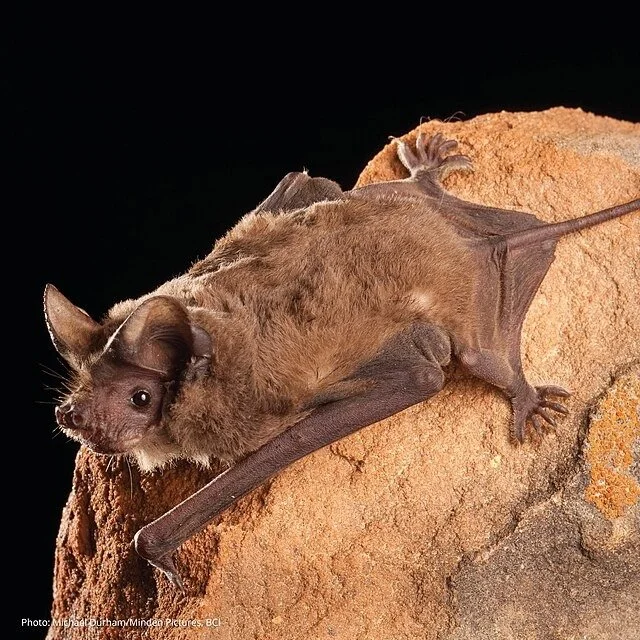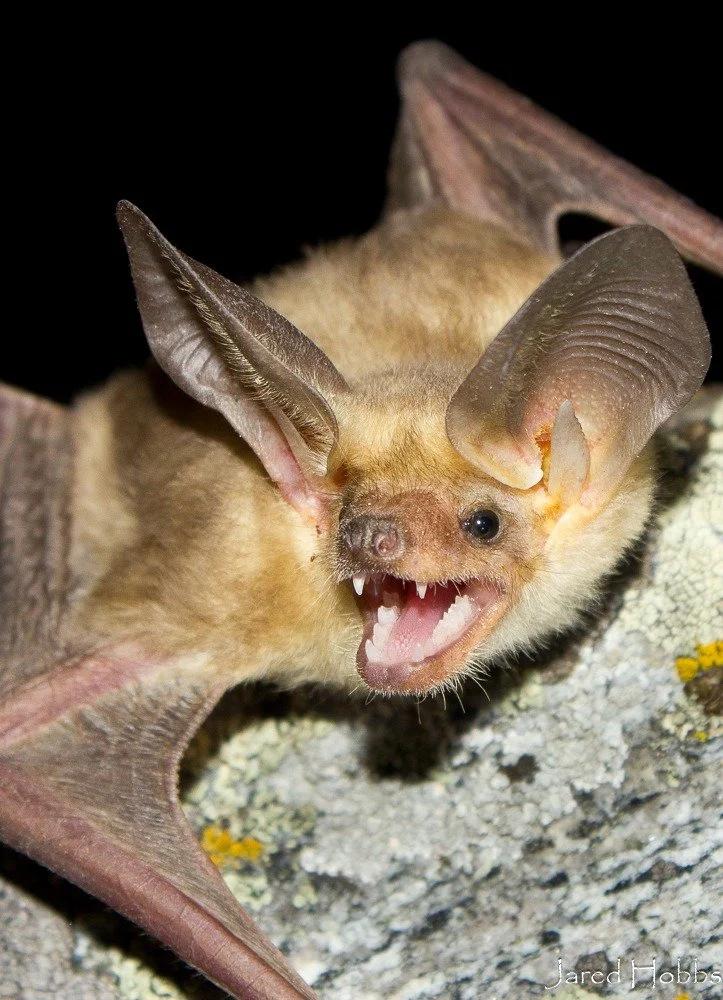Chiroptera’s Got Talent Participants
-

Hoary Bat (Lasiurus cinereus)
Nickname: The Traveler
Home: Hoary bats live in North America and South America
🎨 Talent:
Hoary bats are long-distance migrants, flying high and far. They travel from the Pacific Northwest in the fall, likely overwintering in California and Mexico. One tagged male hoary bat even made a remarkable journey from northern California to the Puget Sound region, covering a significant distance before turning back to California!✨ Interesting Facts:
The Hoary Bat has the widest geographic distribution of any bat in the New World.
They roost in the foliage of trees, often away from others.
Female hoary bats usually roost solitarily
Picture by Paul Cryan
-

Painted Woolly Bat (Kerivoula picta)
Nickname: Master of Disguise
Home: Dry forests in India and Southeast Asia.
🎨 Talent:
While these bats could also compete for best dressed, they truly shine with their clever camouflage! Deep in the forests of Thailand, this eye-catching bat roosts among brightly colored bunches of bananas. Their brilliant orange fur and deep green to black and orange wings help them blend in perfectly, resembling the rotting peels of older (and less tasty) bananas. This disguise keeps them safe as they sleep away the day!✨ Interesting Facts:
Painted bats primarily feed on web spiders and insects found in dense vegetation.
They have a distinctive fluttering flight pattern that sets them apart from other bats, likely aiding them in navigating through thick foliage.
Picture by MerlinTuttle.org
-

Honduran White Bat (Ectophylla alba)
Nickname: Forest Architect🌿
Home: Tropical forests in Central America.
🎨 Talent:These clever bats construct "tents" out of understory plant leaves by strategically cutting the leaf ribs with their teeth! They roost in these cozy tents in small groups during the day for several weeks at a time. Talk about innovative architecture!
✨ Interesting Facts:
It’s one of the few bat species with stunning white fur!
This little bat specializes in munching on the fruits of one particular species of fig, which is available throughout much of the year.
Fun fact: In the Pokémon world, the adorable creature Woobat is inspired by the Honduran white bat!
Picture by Leyo, Wikimedia Commons
-

Greater Bulldog Bat (Noctilio leporinus)
Nickname: Master Fisherman
Home: Central and South America
🎨 Talent:
The Greater Bulldog Bat is one of the few bat species that dines on fish! It spots small fish that are jumping and uses echolocation to detect ripples on the water’s surface. It may also drag its large feet across the water to search for fish activity. Once it locates its prey, it catches the fish with the sharp claws of its very large feet!✨ Interesting Facts:
This bat gets its name from its hanging jowls that conceal internal stretchy cheek pouches.
After capturing prey with its feet, the bat transfers it to its mouth, briefly chews it, and stores it in its cheek pouches—all while flying!
The Greater Bulldog Bat is quite large for a New World bat species, boasting a wingspan of up to 70 cm (27.5 inches).
It’s also a capable swimmer and can use its wings to paddle through the water.
Picture by Juan Cruzado Cortés
-

Spectacled Flying Fox (Pteropus conspicillatus)
Nickname: Professor of Culinary Arts
Home: Northeast Coast of Queensland, Australia.
🎨 Talent:These magnificent bats are champions of Rain Forest Regeneration! Living in and around the world’s oldest tropical rainforest, the Daintree, they support this diverse ecosystem by consuming and dropping fruit seeds across the forest, helping to plant the first large vegetation in damaged habitats. They also pollinate essential flowers and plants that other animals depend on. Their long-distance flight and large size allow them to travel where smaller seed dispersers dare not go!
✨ Interesting Facts:
Flying foxes are the largest bats in the world, with some having wingspans of over five feet!
They locate food using their keen sense of smell.
Unlike many bats, these species navigate with exceptional eyesight as they cannot echolocate.
Picture by Shek Graham, Wikimedia
-

Mexican Free-tailed Bat (Tadarida brasiliensis)
Nickname: Aerial Speedster
Home: North America, Central and South America, and the Caribbean.
🎨 Talents:
Colony Formation: These bats form enormous colonies, with the largest known bat roost at Bracken Cave, Texas, hosting an astonishing 10 to 20 million bats! It’s the largest aggregation of mammals on Earth.
Speed Flight: Mexican Free-tailed Bats have long, narrow wings that enable them to achieve the fastest flight recorded in a bat, clocked at an incredible 100 mph (though tailwinds may have contributed to this speed)!
✨ Interesting Facts:
Their tails are almost half their total length and extend well beyond the tail membrane, giving them their name "free-tailed" bats.
Some populations are migratory, spending spring and summer in North America and flying farther south for the winter.
Picture by Michael Dunham
These bats primarily feed on moths, including agricultural pests like the cotton bollworm moth and army cutworm moths. The Mexican Free-tailed bats of Texas are estimated to consume about 9,100 metric tons (10,000 tons) of insects per year! They hunt insects in the open, sometimes several thousand feet in the air, using echolocation calls and specialized wing and ear anatomy for this hunting style.tion goes here
-

Pallid Bat (Antrozous pallidus)
Nickname: Eating Award Champion
Home: Dry open habitats of western North America.
🎨 Talent:
This local competitor is a world-class eater, especially for a temperate climate dweller! Primarily a gleaning bat, Pallids use their remarkable ears to overhear critters crawling along the desert sands, strong wings to pluck and fly off with their prey, and an impressive immunity to venom to tackle tough meals like scorpions, millipedes, centipedes and occasionally lizards & rodents. They can also capture flying prey mid-air. Further south, Pallid Bats have developed a sweet tooth and regularly feed on the nectar, pollen, and fruits of columnar cacti.✨ Interesting Facts:
Pallid bats have an increased immunity to scorpion venom, allowing them to withstand several stings.
In the Sonoran Desert of Baja California, they feed on nectar and pollen, playing a vital role in pollinating columnar cacti.
Unlike most insectivorous bats, Pallid capture most of their prey on the ground.
Picture by Jared Hobbs
-

White-Lined Bat (Saccopteryx bilineata)
Nickname: Renowned Singer/Songwriter 🎶
Home: Moist tropical forests in Central and Northern South America.
🎨 Talent:
The White-Lined Bat is the best-studied communicator among bat species! These bats are quite chatty: mothers and pups call to each other, pups babble to themselves, and adult males sing to advertise their territory and court females. Males can croon complex songs for up to an hour in the morning as females return to the roost. Their vocal talents truly set them apart in the bat world! 🎤✨ Interesting Facts:
Their social system resembles a harem, with one male among a dozen or so females and their young. He defends the roost site, which may be a hollow tree or the side of a building, from other males.
Females from a roost often forage together in groups, capturing insects in flight.
Picture by Albert Meerscheidt
